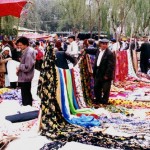Kashgar, “in between the West and the East”
Located close to the southwest border of the Xinjiang, it is the extreme west of China, famous for its connection purpose between two branches of the ancient Silk Road, the road from Eastern and Central China branches out to both the north and south of the Taklamakan Desert. The locals are characterized by a blend of different populations such as, Uyghurs, Han Chinese, Kyrgyz, Tajiks and Uzbecks, shaping an interesting ethnic group.
Kashgar aiport is situated only 15 miles north of the city centre, most of the flights are available from Urumqi, and with less frequency it is also possible to fly from Beijing, Shanghai, and Guangzhou. Also check China flights or China Travel in order to arrange a tour operator.

Nowadays the city of Kashgar still represents a big commerce centre, an oasis in the middle of the desert that it makes possible to experience antique traditions and purchase unique kind of goods especially within the Sunday Market at the Mal Bazaars, where is possible to purchase the speciality of the location such as “kilims” (traditional carpet) and the colourful Central Asia hat.
The city being situated at half way through between Rome and Beijing represented a place where merchants of the past could refresh and relief themselves before leaving for the second half of the Silk Road. The city’s cultures and architectures differ from others Chinese ones due to its Central Asia influences visible on the landscapes and traditions. However the city and its surroundings offer unmissable attractions, such the Mor Buddisht Pagoda situated 34 miles away from Kashgar.
The monument is dated back on the 7th century during the Thang Dynasty, representing one of the oldest around the area. The building has suffered several damages during the 12th century leaving only one Pagoda still erected. The Pagoda has a very cleaver structural design, mainly made of three square layers, each one a little bit smaller than the one below, that creates its round shape. The edifice was place of prayer for monks; its particularity is that the construction it is erected on a hill in the middle of the desert, giving the opportunity to take amazing pictures and spot unforgivable landscapes. Next to the still existing pagoda, is a platform which it was the base of the main destroyed edifice; however carved niches refiguring Buddha’s dolls are still visible today in some of the walls.

Tourists are also welcome to visit the Old Town; the latter indeed is shaped by winding streets featured with traditional architectures. Within the city is also possible to visit the Id Kah Mosque first built in 1442, its yellow walls and the middle Asia architecture make it outstanding from the rest of the city. However women are usually not allowed inside, but modestly dressed foreigners have generally no problems to visit the site, in either case tourists should remove their shoes before visiting as the structure is still a place of prayer. In top of this there are still 3 tombs to visit within the city centre, such as the Tomb of Mahumud, Tomb of Yusup Khass Hajip and Tomb of Apak Hoja.
It is possible to stay in the location thanks to the few hotels around the areas, we strongly recommend Qiniwak hotel, for more information and booking transactions also check China Hotels.




















